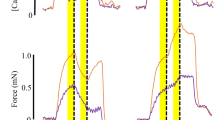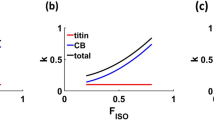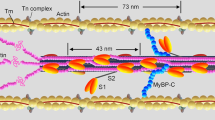Abstract
Muscle contraction is driven by the cyclical interaction of myosin with actin, coupled with ATP hydrolysis. Myosin attaches to actin, forming a crossbridge that produces force and movement as it tilts1 or rocks into subsequent bound states2 before finally detaching. It has been hypothesized that the kinetics of one or more of these mechanical transitions are dependent on load, allowing muscle to shorten quickly under low load, but to sustain tension economically, with slowly cycling crossbridges under high load conditions2,3,4,5,6. The idea that muscle biochemistry depends on mechanical output is termed the 'Fenn effect'. However, the molecular details of how load affects the kinetics of a single crossbridge are unknown. Here, we describe a new technique based on optical tweezers to rapidly apply force to a single smooth muscle myosin crossbridge. The crossbridge produced movement in two phases that contribute 4 nm + 2 nm of displacement. Duration of the first phase depended in an exponential manner on the amplitude of applied load. Duration of the second phase was much less affected by load, but was significantly shorter at high ATP concentration. The effect of load on the lifetime of the bound crossbridge is to prolong binding when load is high, but to accelerate release when load is low or negative.
This is a preview of subscription content, access via your institution
Access options
Subscribe to this journal
Receive 12 print issues and online access
$209.00 per year
only $17.42 per issue
Buy this article
- Purchase on Springer Link
- Instant access to full article PDF
Prices may be subject to local taxes which are calculated during checkout




Similar content being viewed by others
References
Huxley, H.E. The mechanism of muscular contraction. Science 164, 1356–1366 (1969).
Huxley, A.F. & Simmons, R.M. Proposed mechanism of force generation in striated muscle. Nature 233, 533–538 (1971).
Fenn, W.O. A quantitative comparison between the energy liberated and the work performed by the isolated sartorius muscle of the frog. J. Physiol. (Lond) 58, 175–203 (1923).
Rall, J.A. Sense and nonsense about the Fenn effect. Am. J. Physiol. 242, H1–H6 (1982).
Cooke, R. Actomyosin interaction in striated muscle. Physiol. Rev. 77, 671–697 (1997).
Murphy, R.A. What is special about smooth muscle? The significance of covalent crossbridge regulation. Faseb J. 8, 311–318 (1994).
Irving, M. et al. Tilting of the light-chain region of myosin during step length changes and active force generation in skeletal muscle. Nature, 375, 688–691 (1995).
Piazzesi, G. et al. Mechanism of force generation by myosin heads in skeletal muscle. Nature, 415, 659–626 (2002).
Smith, D.A. & Geeves, M.A. Strain-dependent crossbridge cycle for muscle. Biophys. J. 69, 524–537 (1995).
Visscher, K., Schnitzer, M.J. & Block, S.M. Single kinesin molecules studied with a molecular force clamp. Nature 400, 184–189 (1999).
Rief, M. et al. Myosin V stepping kinetics: a molecular model for processivity. Proc. Natl Acad. Sci. USA, 97, 9482–9486 (2000).
Guilford, W.H. et al. Smooth and skeletal muscle myosins produce similar unitary forces and displacements in the laser trap. Biophys. J. 72, 1006–1021 (1997).
Tyska, M.J. et al. Two heads of myosin are better than one for generating force and motion. Proc. Natl Acad. Sci USA 96, 4402–4407 (1999).
White, H.D. & Taylor, E.W. Energetics and mechanism of actomyosin adenosine triphosphatase. Biochemistry 15, 5818–5826 (1976).
Cremo, C.R. & Geeves, M.A. Intercation of actin and ADP with the head domain of smooth muscle myosin: implications for strain dependent ADP release in smooth muscle. Biochemistry 37, 1969–1978 (1998).
Siemankowski, R.F., Wiseman, M.O. & White, H.D. ADP dissociation from actomyosin subfragment S1 is sufficiently slow to limit the unloaded shortening velocity in vertebrate muscle. Proc. Natl Acad. Sci USA 82, 658–662 (1985).
Marston, S.B. & Taylor, E.W. Comparison of the myosin and actomyosin ATPase mechanisms in the four types of vertebrate muscles. J. Mol. Biol. 139, 573–600 (1980).
Molloy, J.E., Burns, J.E., Kendrick-Jones, J., Tregear, R.T. & White, D.C.S. Movement and force produced by a single myosin head. Nature 378, 209–212 (1995).
Veigel, C., Bartoo, M.L., White, D.C.S., Sparrow, J.C. & Molloy, J.E. The stiffness of rabbit skeletal acto-myosin crossbridges determined with an optical tweezers transducer. Biophys. J. 75, 1424–1438 (1998).
Veigel, C. et al. The motor protein myosin-I produces its working stroke in two steps. Nature 398, 520–533 (1999).
Veigel, C., Wang, F., Bartoo, M.L., Sellers, J.R. & Molloy, J.E. The gated gait of the processive molecular motor, myosin V. Nature Cell Biol. 4, 59–65 (2002).
Howard, J. Mechanics of Motor Proteins and the Cytoskeleton (Sinauer Associates, Sunderland, Massachusetts, 2001).
Whittaker, M. et al. A 35-Å movement of smooth muscle myosin on ADP release. Nature 378, 748–751 (1995).
Gollub, J., Cremo, C.R. & Cooke, R. ADP release produces a rotation of the neck region of smooth myosin but not skeletal myosin. Nature Struct. Biol. 3, 796–802 (1996).
Nishiye, E., Somlyo, A.V., Török, K. & Somlyo, A.P. The effects of MgADP on crossbridge kinetics: a laser flash photolysis study of Guinea-pig smooth muscle. J. Physiol. (Lond.) 460, 247–271 (1993).
Dantzig, J.A., Barsotti, R.J., Manz, S., Sweeney, H.L. & Goldman, Y.E. The ADP release step of the smooth muscle crossbridge cycle is not directly associated with force generation. Biophys. J. 77, 386–397 (1999).
Khromov, A.S., Somlyo, A.P. & Somlyo, A.V. Photolytic release of MgADP reduces rigor force in smooth muscle. Biophys. J. 80, 1905–1914 (2001).
Dillon, P., Aksoy, M.O., Driska, S.P. & Murphy, R.A. Myosin phosphorylation and the crossbridge cycle in arterial smooth muscle. Science 211, 495–497 (1981).
Kendrick-Jones, J., Cande, W.Z., Tooth, P.J., Smith, R.C. & Scholey, J.M. Studies on the effect of phosphorylation of the 20,000 Mr light chain of vertebrate smooth muscle myosin. J. Mol Biol. 165, 139–162 (1983).
Perrie, W.T. & Perry, S.V. An electrophoretic study of the low-molecular-weight components of Myosin. Biochem. J. 119, 31–38 (1970).
Scholey, J.M., Taylor, K.A. & Kendrick-Jones, J. Regulation of non-muscle myosin assembly by calmodulin-dependent light chain kinase. Nature 287, 233–235 (1980).
Acknowledgements
We would like to thank The Royal Society, the Medical Research Council and the Biotechnology and Biological Sciences Research Council for financial support, A.F. Huxley, D.R. Trentham, P.M. Bayley, and D.C.S. White for helpful discussions and comments, and M.L. Bartoo and Y. E. Goldman for help and ideas in the early stages of this work.
Author information
Authors and Affiliations
Corresponding author
Ethics declarations
Competing interests
The authors declare no competing financial interests.
Rights and permissions
About this article
Cite this article
Veigel, C., Molloy, J., Schmitz, S. et al. Load-dependent kinetics of force production by smooth muscle myosin measured with optical tweezers. Nat Cell Biol 5, 980–986 (2003). https://doi.org/10.1038/ncb1060
Received:
Accepted:
Published:
Issue Date:
DOI: https://doi.org/10.1038/ncb1060
This article is cited by
-
A mutation in switch I alters the load-dependent kinetics of myosin Va
Nature Communications (2023)
-
F-actin architecture determines constraints on myosin thick filament motion
Nature Communications (2022)
-
Forces of Change: Optical Tweezers in Membrane Remodeling Studies
The Journal of Membrane Biology (2022)
-
What factors determine the number of nonmuscle myosin II in the sarcomeric unit of stress fibers?
Biomechanics and Modeling in Mechanobiology (2021)
-
Myosin 1b is an actin depolymerase
Nature Communications (2019)



